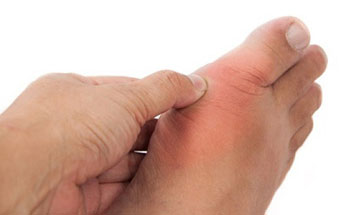
SESAMOID INJURIES
WHAT IS IT?

To understand sesamoid injuries in the foot, it's imporant to know what sesamoids are. A sesamoid is a bone embedded in a tendon. Sesamoids are found in several joints in the body. In the normal foot, the sesamoids are two pea-shaped bones located in the ball of the foot, beneath the big toe joint.
Acting as a pulley for tendons, the sesamoids help the big toe move normally and provide leverage when the big toe pushes off during walking and running. The sesamoids also serve as a weightbearing surface for the first metatarsal bone (the long bone connected to the big toe), absorbing the weight placed on the ball of the foot when walking, running and jumping.
Sesamoid injuries can involve the bones, tendons and/or surrounding tissue in the joint. They are often associated with activities requiring increased pressure on the ball of the foot, such as running, basketball, football, golf, tennis and ballet. In addition, people with high arches are at risk for developing sesamoid problems. Frequent wearing of high-heeled shoes can also be a contributing factor.

TREATMENT
Nonsurgical Treatment
Nonsurgical treatment for sesamoid injuries of the foot may include one or more of the following options, depending on the type of injury and degree of severity:
- Padding, strapping or taping. A pad may be placed in the shoe to cushion the inflamed sesamoid area, or the toe may be taped or strapped to relieve that area of tension.
- Immobilization. The foot may be placed in a cast or removable walking cast. Crutches may be used to prevent placing weight on the foot.
- Oral medications. Nonsteroidal anti-inflammatory drugs (NSAIDs), such as ibuprofen, are often helpful in reducing the pain and inflammation.
- Physical therapy. The rehabilitation period following immobilization sometimes includes physical therapy, such as exercises (range of motion, strengthening and conditioning) and ultrasound therapy.
- Steroid injections. In some cases, cortisone is injected into the joint to reduce pain and inflammation.
- Orthotic devices. Custom orthotic devices that fit into the shoe may be prescribed for long-term treatment of sesamoiditis to balance the pressure placed on the ball of the foot.
When Is Surgery Needed?
When sesamoid injuries fail to respond to nonsurgical treatment, surgery may be required. The foot and ankle surgeon will determine the type of procedure that is best suited to the individual patient.

WHY CHOOSE A FOOT AND ANKLE SURGEON?
Foot and ankle surgeons are the leading experts in foot and ankle care today. As doctors of podiatric medicine – also known as podiatrists, DPMs or occasionally “foot and ankle doctors” – they are the board-certified surgical specialists of the podiatric profession. Foot and ankle surgeons have more education and training specific to the foot and ankle than any other healthcare provider.
Foot and ankle surgeons treat all conditions affecting the foot and ankle, from the simple to the complex, in patients of all ages including Haglund's deformity. Their intensive education and training qualify foot and ankle surgeons to perform a wide range of surgeries, including any surgery that may be indicated for Haglund's deformity.

